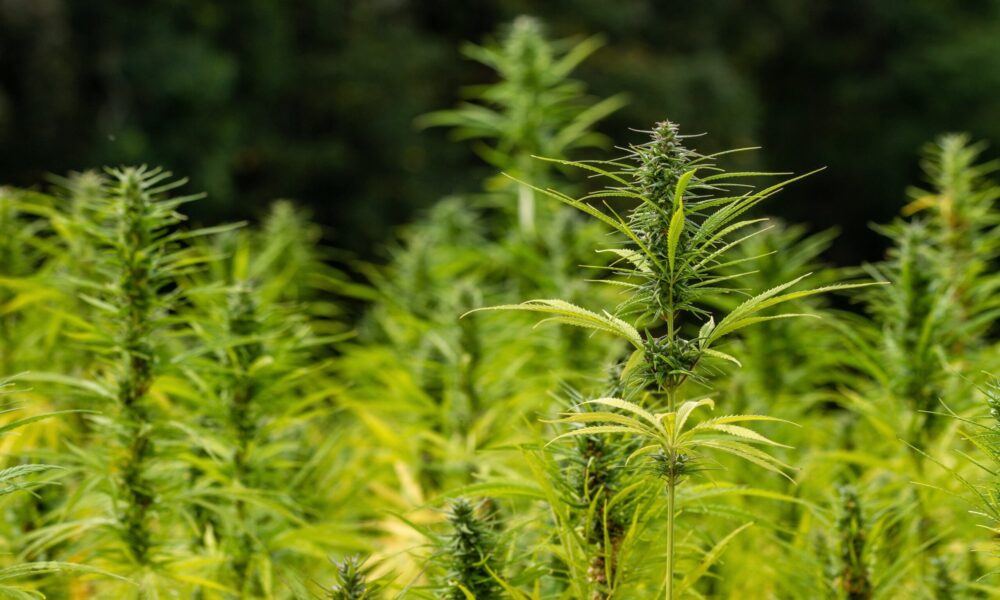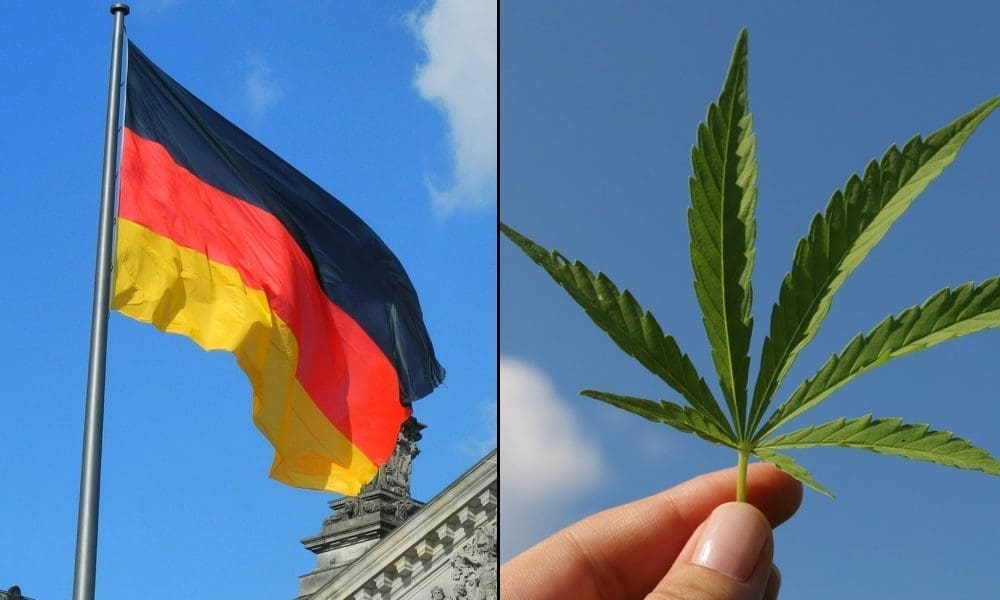featured
South Dakota Farmers See Hemp As A Way To Bring Jobs To Small Towns And Absorb Carbon
Published
2 days agoon

“Hemp absorbs carbon as it grows, and we can lock the carbon into the various materials produced.”
By Joshua Haiar, South Dakota Searchlight
Ken Meyer’s boots imprint the fine layer of dust settled over the concrete floor as he walks through South Dakota’s first industrial hemp processing facility.
It’s loud. Fans whirl and machinery grinds. Strips of sunlight cut through the haze.
Piles of dry hemp stalks line one wall. Meyer gestures toward a forklift feeding one of the piles into an industrial contraption.
On one side of the machine, fiber pours out in tangled ribbons. On another, chunks of the woody core, called “hurd,” tumble into a large sack atop a pallet. Meyer reaches in and raises a handful.
“We can turn hemp stalks into materials for animal bedding, hempcrete, bioplastics, you name it,” he said. “Right here in South Dakota.”
Meyer has a vision. He said expanding the hemp supply chain in South Dakota will bring more small processing and manufacturing into the state, and pull heat-trapping carbon dioxide from the atmosphere.
“Hemp absorbs carbon as it grows, and we can lock the carbon into the various materials produced,” Meyer said. “And all that manufacturing could happen here in South Dakota.”
But coordinating the investments, infrastructure, oversight and market development needed to realize that vision is more work than Meyer alone can accomplish with his company, Complete Hemp Processing.
In Wakonda, John Peterson with Dakota Hemp is not only constructing the state’s second processing facility but is also a hemp farmer.
“We can’t just have everybody start planting hemp,” Peterson said. “You need the whole chain—growers, processors, and manufacturers—to come online at the same time. And that’s hard.”
Hemp and carbon
South Dakotans have only been growing hemp since 2021. The state is now the number 1 hemp producer in the country, with 3,700 acres harvested in 2024. To capitalize on hemp’s potential to sequester carbon dioxide and keep it from trapping heat in the atmosphere, millions more acres are needed.
Hemp can grow 16 feet tall in three months. Growing a field of 16-foot-high stalks requires a lot of photosynthesis, which is the way plants absorb carbon dioxide and water to convert sunlight into energy for growth. An acre of hemp stalks absorbs approximately 5.5 tons of carbon per acre each season, according to Brittany McKell, with Hemp Carbon Standard in Canada. She said an additional ton of CO2 per acre is stored in the soil if less invasive tillage practices are used.
Hemp Carbon Standard works with farmers to quantify the amount of carbon sequestered by their hemp farm and convert that to credits. Those are sold on global, private carbon markets where companies and individuals purchase them to offset their greenhouse gas emissions. The company then shares those profits back with farmers. Peterson recently signed up and earned 367 carbon credits on one year’s harvest, which can be sold for over $100 each.
While corn stalks can temporarily store up to about 4 tons of above-ground carbon dioxide per acre, most of it is re-released through digestion and decay.
Decay happens to harvested hemp, too. Keeping the carbon in the hemp stalks requires a longer-term carbon storage solution: processing those stalks into long-lasting materials. Hemp’s utility extends to everything from bioplastics and lumber to textiles and insulation. Hempcrete, for example, is a construction material made from hemp hurd and lime that absorbs CO2 as it sets.
Hemp Carbon Standard promotes the use of those products, too, because McKell said they serve as sustainable, less carbon-intensive alternatives that indirectly offset the production of their more carbon-intensive counterparts: oil-based plastics, wood from trees and energy-intensive construction materials. Depending on the product being made, McKell said, the impact of producing hemp-based, less carbon-intensive alternatives prevents another 9 to 18 tons of CO2 from entering the atmosphere, per acre of hemp allocated to the production of the material.
The numbers mean that if 18 percent of South Dakota’s approximately 18.5 million cropland acres grew hemp every summer, the hemp stalks—not counting the carbon potentially stored in the soil or the material offset of producing less carbon-intensive materials—would remove over 18 million tons of atmospheric carbon per year. That’s as much as a proposal in South Dakota aiming to achieve a similar vision: Summit Carbon Solution’s carbon sequestration pipeline, which would annually capture up to 18 million tons of carbon emissions from 57 ethanol plants in five states. The five-state project has faced numerous regulatory and legal hurdles, along with opposition from landowners refusing to grant access and expressing concerns about potential leaks of toxic carbon dioxide plumes.
Farmers with land crossed by the pipeline would receive easement payments. In hemp production, farmers can capitalize the carbon-storage potential of their crop by selling carbon credits. Hemp also requires no herbicides, unlike other row crops such as corn and soybeans.
Despite its potential, the hemp market faces regulatory challenges. And industrial hemp advocates say getting hemp this far was not easy.
The fight to legalize hemp
Although hemp was federally legalized under the 2018 Farm Bill—which defined hemp as cannabis containing no more than 0.3 percent tetrahydrocannabinol (known as THC, which results in a high at greater concentrations)—South Dakota did not immediately follow suit.
Early efforts to legalize hemp production at the state level were met with resistance, particularly from former Gov. Kristi Noem’s (R) administration, which expressed concern that legal hemp could lead to broader marijuana legalization. Oren Lesmeister, a rancher and Democratic former legislator from Parade, spent years fighting to get the hemp industry rolling in South Dakota.
“There was this fear that everyone was going to run out and get stoned,” Lesmeister said. “We had to beat that misconception with education and persistence.”
The legal and regulatory barriers fell in several stages. The first major step was ensuring that South Dakota’s laws aligned with federal standards legalizing the crop, something the 2018 Farm Bill allowed states to do.
Implementation in South Dakota lagged, with hemp cultivation beginning in 2021 after state administrative rules were finalized and approved. Even then, regulatory burdens remained. But Meyer said many of these initial state restrictions have since been scaled back as South Dakota gained experience with the crop.
Meyer said the two major impediments still in place are THC testing requirements and criminal background checks. He hopes those requirements will be loosened in the next federal Farm Bill.
Selling a bottom-up vision
Lesmeister sees parallels with corn-based ethanol, which grew into a major industry with help from the federal government. It created a guaranteed market through the Renewable Fuel Standard, which requires refiners to blend billions of gallons of ethanol into gasoline each year or buy credits. The number of corn acres in South Dakota went from about 4 million before the standard was enacted to about 6 million last year.
“Hemp got this far without any of that,” Lesmeister said. “But imagine where it could be with a little help.”
Doug Sombke, president of the South Dakota Farmers Union, sees helping the emerging hemp industry as a better way to sequester carbon than controversial proposals to capture carbon emitted by ethanol plants.
“If you really want to support the climate and agriculture, get that money to the people working the land,” Sombke said.
Bryan Jorgensen is a regenerative farmer and soil health expert from Ideal. He is skeptical that climate change requires government action. But Jorgensen does see industrial hemp as a chance to rebuild rural communities as part of America’s manufacturing base.
“This could localize manufacturing,” he said. “But it takes vision and the will to invest in producers instead of propping up extractive systems.”
By comparison, he sees carbon pipelines as an extension of a flawed farm economy that has become overly dependent on corn and soybeans, partly due to the federal support for those crops.
“We’ve created this monster,” Jorgensen said. “We’ve invested billions in learning how to grow corn, so now we don’t know how to do anything else. And farmers are stuck in a system where they’re not even the ones benefiting.”
Silvia Secchi, a professor at the University of Iowa who studies agricultural and climate policy, agrees.
“We subsidized the corn, not the farmer,” she said. “That’s the problem.”
For now, the few thousand acres of hemp grown in South Dakota pale in comparison to about 6 million acres of corn and 5 million acres of soybeans. But advocates believe that could change rapidly if hemp processors and manufacturers move in, and the U.S. government backs the vision.
“There’s a real opportunity here,” said Karll Lecher, co-founder of Dakota Hemp. “We just need more boots on the ground.”

Author: mscannabiz.com
MScannaBIZ for all you Mississippi Cannabis News and Information.
You may like
-


The DEA’s New Boss Holds the Keys to Weed Reform: Will He Take Action?
-


Former Erie Co. Home To Cannabis Growth Site?
-


New German Medical Cannabis Restrictions Will Harm Patients And Hinder Industry Growth (Op-Ed)
-


New Survey: 9 in 10 Americans Want Decontaminated Cannabis
-
Dream Of Working In Weed? This Scholarship Could Make It Happen
-


Cresco Labs Exiting California Market as Part of ‘Strategic Restructuring’
featured
The DEA’s New Boss Holds the Keys to Weed Reform: Will He Take Action?
Published
19 minutes agoon
July 24, 2025
After months of silence and bureaucratic stalling, the DEA finally has a new boss: Terrance Cole, confirmed by the Senate earlier this week.
That might not sound like major weed news since it’s the DEA and all, but it is. The federal effort to reschedule cannabis — perhaps the biggest shift in US drug policy in over half a century — now flows directly through him.
Let’s break it down: Cannabis is still a Schedule I substance under federal law, the same category as heroin and LSD, meaning the government officially considers it to have no medical value and a high potential for abuse. Yes, even in 2025, after nearly half of the U.S. states have legalized cannabis for adults to buy and consume.
Rescheduling to Schedule III, alongside Tylenol with codeine and anabolic steroids, wouldn’t legalize cannabis outright. But it would mark the biggest federal policy shift since the Nixon Administration launched the War on Drugs in 1970.
Cole told lawmakers prior to his confirmation that advancing the rescheduling process, initiated by the Biden Administration but since stalled under President Trump, is one of his top priorities.
That’s the good news.
The not-so-good? He has a long track record of anti-cannabis statements and refused to give direct answers about what outcome he wants for the process. He’s playing it close to the chest.
Then came a twist: Just one day after Cole’s confirmation, the DEA’s administrative law judge overseeing the rescheduling process, John Mulrooney, announced his retirement. In a letter, he said all matters now go straight to the DEA Administrator. That’s Cole.
The cannabis industry is cautiously spinning Cole’s appointment as a win. That’s mostly because it’s been starving for any federal progress. Hearings were supposed to begin in January but quickly got bogged down by procedural fights, witness disputes, and a general lack of urgency.
So now, he has two choices:
- Finalize the rescheduling recommendation and jam it through himself — unlikely, but possible.
- Appoint a new judge and restart hearings from scratch. That would mean more delays and more dysfunction. More on that below.
If rescheduling happens, the implications are massive, especially for cannabis businesses.
The biggest shift? Eliminating IRS Code 280E, a tax rule that bars cannabis operators from deducting normal expenses like payroll, rent, and office supplies. That rule has gutted balance sheets and pushed even profitable companies into the red.
Rescheduling could also unlock access to banking, ease mergers and acquisitions, and possibly even allow U.S. cannabis firms to list on major stock exchanges — though it’s unclear if Nasdaq or NYSE would permit that under Schedule III.
For social equity operators, it could be a lifeline. States like New York and Illinois established these licensing programs to give entrepreneurs harmed by the War on Drugs a first crack at the newly legal market. But the lack of federal reform and banking access has left many undercapitalized, buried in debt, and unable to open. New investment and lower capital costs could give them some breathing room.
But here’s the rub: Many grassroots advocates worry Schedule III could cement the dominance of deep-pocketed multistate operators like Curaleaf and Green Thumb Industries that cultivate and sell cannabis in multiple states. These companies already have the compliance teams, legal firepower, and capital to navigate federal ambiguity — and now, potentially, tax relief too.
Rescheduling doesn’t legalize cannabis. It doesn’t expunge records. And it technically wouldn’t stop federal agencies from hassling state-legal operators if they wanted to. It just makes the math easier — for the businesses that are already surviving.
Trump has political reasons to move on cannabis reform. He backed rescheduling during the campaign — meaning it would be a fulfilled campaign promise — and it could distract from Epstein file fallout and DOJ scandals. More importantly, he’s hemorrhaging Gen Z support, and they overwhelmingly back cannabis reform.
It also gives Trump a way to split the difference in his big-tent party. It’s not full legalization (which could trigger backlash from the religious Ron DeSantis/Mike Johnson wing), but it is a policy win that helps small American businesses, plays well with young voters, and looks like reform and a broadly popular issue without going all the way.
It’s a politically useful half-measure. But in this administration, it might be the best we get. Now that Judge Mulrooney’s out, the ball is squarely in Cole’s court.
Will he push it through? Or slow-walk it into oblivion? The industry’s watching. Closely.
Editor’s note: Check out more of Jeremy’s work over at Cultivated — one of our favorite sources for smart, nuanced cannabis coverage.
Photo by Thom Milkovic on Unsplash

Author: mscannabiz.com
MScannaBIZ for all you Mississippi Cannabis News and Information.
featured
New German Medical Cannabis Restrictions Will Harm Patients And Hinder Industry Growth (Op-Ed)
Published
1 hour agoon
July 24, 2025
“Despite significant and stable market growth, certain proposed policy changes that have been drafted may hinder industry progress and restrict patient access.”
By Niklas Kouparanis, Bloomwell Group
A new threat looms over the burgeoning medical cannabis market in Germany.
Recently, the German Health Ministry released a draft amendment that would require patients to have an in-person consultation annually and would bar prescriptions from being delivered by mail. While this is a draft and is likely to be changed during the legislative process, many are questioning the potential effects of policies like these on an otherwise growing and stable market.
Will this stall or even curtail future success?
Where the German medical cannabis market currently stands
Since the passage of the Cannabis Act (CanG) in April 2024, Germany has experienced significant growth in the country’s medical cannabis market due to cannabis being reclassified cannabis as a non-narcotic. This removed unnecessary administrative burdens on the medical cannabis market and allowed more patients to access the plant as a wellness treatment.
Prior to CanG being implemented last year, there were an estimated 200,000 to 300,000 medical cannabis patients in the German market. As of May 2025—just over one year after CanG went into effect—Whitney Economics estimates that there are now an additional 500,000 to 600,000 patients participating in the legalized self-paying market.
I predict that we could soon see a million patients if the market can grow under its current regulatory conditions.
As reported by the Federal Institute for Drugs and Medical Devices (BfArM), Germany imported over 37.223 metric tonnes of medical cannabis products in the first quarter of 2025. This number represents a noteworthy increase as the total imports for Q1 2025 increased by roughly 14.8 percent compared to the Q4 2024 total (32.419 metric tonnes). Compared to the same period a year prior, the Q1 2025 import numbers represent an increase of over 457 percent.
Proposed changes seek to put patient access at risk
Despite significant and stable market growth, certain proposed policy changes that have been drafted may hinder industry progress and restrict patient access.
In July 2025, the German Health Ministry released a draft amendment that would require patients to have an in-person consultation at a physician’s office or during a home visit once a year to be prescribed medical cannabis and also as a first step before starting their therapy.
In addition, medical cannabis treatments would no longer be able to be delivered by mail order. Patients would have to pick up their treatments at physical pharmacy locations.
Such legislative changes to current German cannabis law are led under the direction of Federal Health Minister Nina Warken, who is seeking to restrict patient access to medical cannabis. Warken has emphasized that record-high cannabis imports have increased beyond what was anticipated.
Report Reveals Digital Access Restrictions Would Push Patients to Illicit Market
According to German medical cannabis company Bloomwell Group’s latest report, “The Cannabis Barometer–Potential Consequences of Restricted Telemedicine Access,” which surveyed 2,500 medical cannabis patients in Germany, 41.7 percent of patients would revert to the illicit market if digital access were blocked.
Such findings suggest that digital access to licensed, physician-supervised cannabis therapy has successfully transitioned hundreds of thousands of patients away from unsafe, unregulated sources and into safe, pharmacy-distributed care.
Additionally, Bloomwell found that medical cannabis patient numbers show no signs of slowing down: In May and June 2025, the number of prescriptions filled on the company’s digital platform exceeded those from March 2024—the final month before medical cannabis was reclassified—by more than 1,100 percent, a new record high.
Other key findings from the Cannabis Barometer report included:
- Only 7 percent would consider joining one of Germany’s legal cannabis clubs, which mainly serve recreational users.
- Seventy-nine percent of patients previously relied on unlicensed sources (illegal market and/or through friends and acquaintances) before accessing digital therapy.
- Forty-seven and a half percent now say cannabis obtained from pharmacies is less expensive than unlicensed products, debunking myths about affordability. Only 13.8 percent responded that pharmacy cannabis is more expensive.
- Eighty-three percent believe medical cannabis from pharmacies is of higher quality than illicit alternatives.
Public and safety benefits of digital access
As mentioned, the passage of CanG allowed for further patient access to the legalized medical cannabis system. Such access prompted some individuals to shift from the illicit market to the regulated medical system, as they could now access prescribing physicians and treatments through digital platforms—signaling a significant harm reduction and an overall win for major public health.
Restricting digital access not only reverses this trend but also reintroduces substantial risks associated with unlicensed products, such as contamination, mislabeling and improper packaging that isn’t child-resistant.
Overlooked by critics of the legalized telemedical cannabis industry is that digital consultations for patients still involve licensed prescribing physicians, helping to ensure proper oversight and usage. Removing this channel simply undermines patient access without any apparent benefit.
Access equality for disabled and rural populations
Medical cannabis treatment is often prescribed to patients experiencing conditions that can vary in severity and may limit their mobility. Patients with chronic conditions, immunocompromised and disabilities can find it extremely difficult to travel to physicians’ offices for in-person consultations. The same issue applies to Germans living in rural areas.
These patients depend on digital consultations and mail-in orders to treat their medical conditions. Also, since there are a limited number of doctors in Germany who prescribe medical cannabis, many of these patients may be left without access and may have to turn to the illicit market.
Economic impact of restriction of access
The proposed policy changes not only pose harm to patients but also hinder the market’s growth. The German medical cannabis industry has demonstrated significant and stable development, generating job opportunities, tax revenue and investment opportunities. Regressive policies could slow or upend progress.
As mentioned in the Cannabis Barometer report, 41.7 percent of German medical cannabis patients stated that they would seek cannabis through illicit sources if their digital access were restricted. If that is the case, a large portion of economic activity would shift from regulated, taxable sales to the illicit market.
While we continue to consider these points, it’s important to remember that we are still at the beginning of the policy process and are hopeful that these changes are unlikely to be implemented. The German market will continue to thrive.
Niklas Kouparanis is CEO and co-founder of Bloomwell Group. Since 2017, he’s been a serial entrepreneur, medical cannabis pioneer, founder and growth activator of companies, all while shaping the future of the European cannabis industry.

Author: mscannabiz.com
MScannaBIZ for all you Mississippi Cannabis News and Information.
featured
New Survey: 9 in 10 Americans Want Decontaminated Cannabis
Published
2 hours agoon
July 24, 2025
[PRESS RELEASE] – LAS VEGAS, July 24, 2025 – A recent nationwide survey underscores a compelling truth in the cannabis industry: While there is significant support for the decontamination of cannabis to eliminate harmful pathogens such as mold and bacteria, most individuals are still unaware of how this is achieved and the various technologies behind it.
According to a survey of over 500 Americans, commissioned by XRPure, an overwhelming 91.7% of respondents believe medical cannabis should be decontaminated. Similarly, 90.5% agree that cannabis brands should be required to label their packaging if the product has been decontaminated. Yet, when it comes to understanding the available methods—X-ray, ozone, and radiofrequency (RF) technologies—only 1 in 4 respondents (26.4%) said they were confident in their knowledge.
“This survey reflects a major gap in awareness of how we can make cannabis cleaner and safer to consume,” said Jeff Adams, founder and Managing Director of XRPure, a company propelling innovation in cannabis decontamination using X-ray energy. “Consumers are clearly demanding transparency and safety in their cannabis products, but we as an industry need to do a better job in fully communicating how those safety standards are met.”
Additional findings include:
- 53.7% said they would be more likely to purchase decontaminated cannabis flower
- Only 15.7% would be less likely to do so.
- 43.8% of respondents admitted they do not understand the differences between the main decontamination methods used today
The survey, which included adult participants across diverse age groups, income brackets, and U.S. regions, confirms that decontamination is no longer a niche concern—it’s a mainstream expectation. It also signals an important opportunity for cannabis brands and regulatory agencies to prioritize publicizing that the flower has been decontaminated, the method that was used to do so, and why this is significant.
“This all starts with labeling, but we need to strive to go beyond that,” Adams said. “If we’re going to foster trust in the cannabis industry and ensure product safety, we must also invest in educating consumers about what decontamination is, why it matters, and how it’s done.”
Unlike traditional chemical or heat-based decontamination methods, XRPure’s proprietary machines use X-ray technology to fully penetrate the cannabis flower, breaking down microbial DNA and rendering them inert. X-rays pass through the plant and leave no trace residue, so the plant can retain its full integrity. By using a cold process that doesn’t affect the chemical properties of the plant, cultivators can now treat their flower post-harvest, before or after packaging, to achieve dramatic—if not total—microbial reduction. This approach crucially boosts the safety of products for both adult-use consumers and medical patients, while helping cultivators reduce costs associated with crop loss and product recalls.
As cannabis legalization expands and product offerings diversify, setting clear standards for safety and transparency is vital. This survey serves as a call to action for producers, lawmakers, and educators alike to bridge the knowledge gap and meet the rising demand for cannabis that not only meets minimum safety standards but is decontaminated to exceed safety standards.
The full survey can be viewed here. For more information about XRPure’s decontamination systems or to request a demo, visit www.xrpure.com.
Survey Methodology:
XRPure commissioned SurveyMonkey to conduct a survey of 500 anonymous Americans ages 18 and up. The survey was conducted in May 2025.

Author: mscannabiz.com
MScannaBIZ for all you Mississippi Cannabis News and Information.

The DEA’s New Boss Holds the Keys to Weed Reform: Will He Take Action?

Former Erie Co. Home To Cannabis Growth Site?

New German Medical Cannabis Restrictions Will Harm Patients And Hinder Industry Growth (Op-Ed)

New Survey: 9 in 10 Americans Want Decontaminated Cannabis
Dream Of Working In Weed? This Scholarship Could Make It Happen

Cresco Labs Exiting California Market as Part of ‘Strategic Restructuring’

What to know about growing cannabis in your home

Marijuana Would Be Legalized In Texas Under New Bill Filed For Special Legislative Session

Drug bust finds pounds of cocaine, cannabis at NY residence: Chautauqua Co. Sheriff’s Office

How Alcohol And Cannabis Affect Gut Health

Inside a huge High Street cannabis farm in Huntingdon

LEEF Brands Announces CAD $1 Million Private Placement

One Dose. Two Years. Psilocybin Can Ease Depression In Cancer Patients, New Research Shows

Mississippi AG takes aim at hemp products, including Delta THC | News

Missouri Supreme Court Rules Counties Cannot ‘Stack’ Cannabis Sales Taxes

Mississippi AG takes aim at hemp products, including Delta THC | TN State News

Oregon Officials Issue Ballot Title For Initiative To Legalize Marijuana Social Lounges

Limiting marijuana use in public | FOX 5 New York

From The Vault: HARVEST HIGHS (1986)

California Bill Would Let ‘Small’ Cannabis Producers Ship Directly to Consumers

DEA Promotes Guide To ‘Decode’ Drug Emojis, Saying The Shocked Face Represents Marijuana 😮

Mississippi AG takes aim at hemp products, including Delta THC | State

Medical Marijuana Provides Relief From Migraine Headaches, With Study Showing THC-CBD Combo Has Most Robust Benefits

Mississippi AG takes aim at hemp products, including Delta THC | State & Regional

Alert: Department of Cannabis Control updates data dashboards with full data for 2023

Connecticut Appoints The US’s First Cannabis Ombudsperson – Yes there is a pun in there and I’m Sure Erin Kirk Is Going To Hear It More Than Once!

5 best CBD creams of 2024 by Leafly

EU initiative begins bid to open access to psychedelic therapies

Free delta-9 gummies from Bay Smokes
New Study Analyzes the Effects of THCV, CBD on Weight Loss

5 best autoflower seed banks of 2024 by Leafly

May 2024 Leafly HighLight: Pink Runtz strain

Curaleaf Start Process Of Getting Their Claws Into The UK’s National Health System – With Former MP (Resigned Today 30/5/24) As The Front Man

Mississippi city official pleads guilty to selling fake CBD products

Discover New York’s dankest cannabis brands [September 2024]

Horn Lake denies cannabis dispensary request to allow sale of drug paraphernalia and Sunday sales | News

Press Release: CANNRA Calls for Farm Bill to Clarify Existing State Authority to Regulate Hemp Products

Local medical cannabis dispensary reacts to MSDH pulling Rapid Analytics License – WLBT

Nevada CCB to Accept Applications for Cannabis Establishments in White Pine County – “Only one cultivation and one production license will be awarded in White Pine County”

5 best THC drinks of 2024 by Leafly

6 best CBD gummies of 2024 by Leafly

The Daily Hit: October 2, 2024

5 best delta-9 THC gummies of 2024 by Leafly

Weekly Update: Monday, May 13, 2024 including, New Guide for Renewals & May Board meeting application deadline

People In This State Googled ‘Medical Marijuana’ The Most, Study Shows

PRESS RELEASE : Justice Department Submits Proposed Regulation to Reschedule Marijuana

Thailand: Pro-cannabis advocates rally ahead of the government’s plan to recriminalize the plant

Press Release: May 9, STIIIZY and Healing Urban Barrios hosted an Expungement Clinic & Second Chance Resource Fair
Trending
-

 California Cannabis Updates1 year ago
California Cannabis Updates1 year agoAlert: Department of Cannabis Control updates data dashboards with full data for 2023
-

 Breaking News1 year ago
Breaking News1 year agoConnecticut Appoints The US’s First Cannabis Ombudsperson – Yes there is a pun in there and I’m Sure Erin Kirk Is Going To Hear It More Than Once!
-

 best list12 months ago
best list12 months ago5 best CBD creams of 2024 by Leafly
-

 Business10 months ago
Business10 months agoEU initiative begins bid to open access to psychedelic therapies
-

 Bay Smokes1 year ago
Bay Smokes1 year agoFree delta-9 gummies from Bay Smokes
-

 cbd1 year ago
cbd1 year agoNew Study Analyzes the Effects of THCV, CBD on Weight Loss
-

 autoflower seeds10 months ago
autoflower seeds10 months ago5 best autoflower seed banks of 2024 by Leafly
-

 California1 year ago
California1 year agoMay 2024 Leafly HighLight: Pink Runtz strain




